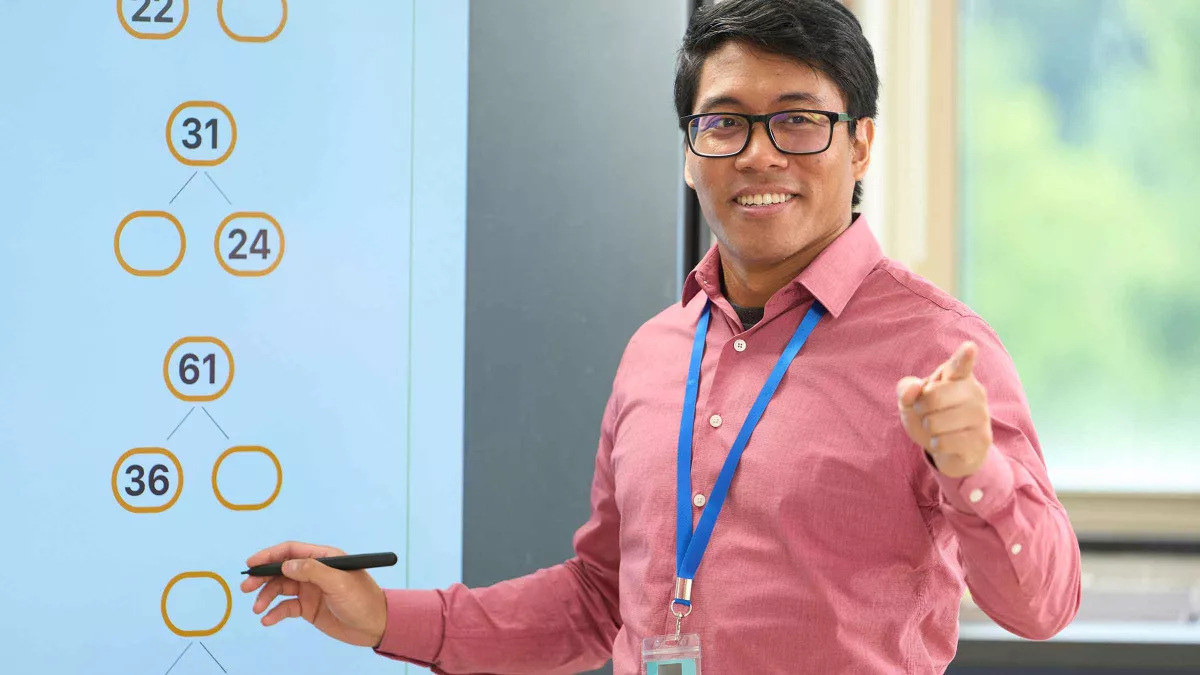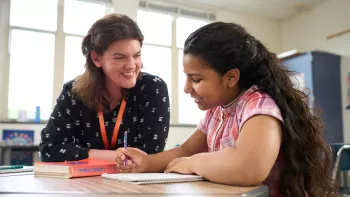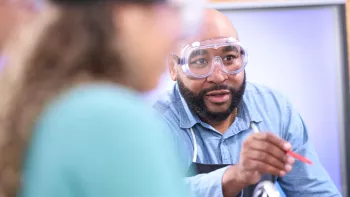How we define 'Professional Teachers'
Vision
The professional teacher is on a rewarding career-long quest for continuous professional growth and pursuit of excellence. As emerging teachers receive full licensure and enter the “professional teacher” phase, they have achieved only an essential foundation. A lifetime of opportunities for growth and countless opportunities to positively impact the lives of students await.
In their pursuit of excellence, professional teachers select learning goals based on their own perceptions of student needs and personal interest. They also collaborate with colleagues to select and plan professional learning for the larger school community. Informal and formal teacher-led professional learning communities (PLCs) identify areas for enhanced student learning and improved school climate.
Professional teachers continue to develop increasing skill and sensitivity in responding appropriately and effectively to issues and opportunities that arise working with students, parents, colleagues, and community members from diverse cultural backgrounds.
Teachers collaborate to identify assessments of student learning and measures of school culture that are used to guide the work of their PLCs in selecting goals and measuring progress.
Teachers review existing research and construct and implement action research projects to determine which strategies to pursue as part of a school’s improvement plan and to develop their own individual practice.
Teachers seek to document their skills through pursuit of National Board Certification and/or other valid and reliable assessments of teaching based on the profession’s standards for accomplished practice.
Teachers participate in professional networks that support professional growth in their content area, grade level, schools, districts, teacher union, and other informal and formal professional groups. Schools, districts, unions, etc., seek to help teachers identify strengths and to support their growth as teachers and leaders of the profession.
Teachers enhance their learning and practice as they participate and grow as leaders during the professional phase of their career. Examples of leadership at this phase might include working with a teacher candidate or mentoring an emerging teacher, facilitating a PLC, advocating for professional learning goals and time, etc.
Professional phase teachers pursue learning opportunities through multiple pathways that link strongly to improved professional practice and to deeper understanding of the content they teach. While pathways to improvement vary greatly — from courses and degree programs in higher education to collaboration with peers (e.g., PLCs) in the same school district and beyond, from workshops and programs in school and district, to teacher-led action research — almost all successful professional learning systems share the following characteristics:
-
Standards for Professional Learning serve as a benchmark for design of all professional learning.
-
Teachers receive personalized supervision of instruction, focused on teacher-led, teacher-driven professional growth with collaboration as a measure of success.
-
Peers engage in coaching as they support each other in a culture of positive collegiality.
-
Professional learning experiences involve extended study of theory embedded with ongoing opportunities to practice new skills over several months/years.
-
Classroom doors are open and individual practice is public for collaboration and peer learning.
-
TPPs are integral partners when they come to the PreK-12 school both as learners and in offering research, workshops, and courses linked to the long-term professional learning goals for individuals and groups of teachers.
-
The union works with the district to ensure that contracts provide the time necessary to embed meaningful, ongoing professional learning activities throughout the school year.
-
Contracts establish an appropriate balance of time spent teaching/supervising students and time engaged in working with colleagues for professional growth.
-
Evaluation of teachers is strongly supported with opportunities for professional growth through peer assistance and coaching, culminating with peer review.
-
Evaluation is tiered, based on an individual teacher’s career phase and experience level.
The Current Landscape
For decades, professional development practices generally lacked focus, involved little or no follow-up, didn’t link to coaching or practice, and were imposed on teachers by administration. Teachers joked about “drive-by” workshops and “sit and get” experiences. In this environment, the perception was that growth and improvement in performance for teachers significantly diminished after about five years in the profession.
Misguided teacher evaluation based on test scores can have devastating effects on teacher morale.
Important evidence to contradict this myth began to emerge, however, as professional learning has increasingly been designed to align with the best research on practice. Many of those best practices can be found in Learning Forward’s Standards for Professional Learning. Additional insights into this evolving narrative follow:
-
Until recently, professional development in the U.S. has typically been implemented without any specific direction or desired outcomes in mind.
-
Professional development in programs consisting of 30-plus hours of experiences, coaching, etc., distributed over six months shows the greatest impact on learning.
-
Some systems seek to script practices of “effective teachers” and mandate that all follow these scripted lessons. The impact of these lessons “actually stunts teachers’ ability to make good classroom decisions and obscures bad teaching with its illusion of uniformity.”
-
Misguided teacher evaluation based on test scores can have devastating effects on teacher morale.
-
Research reveals “extensive evidence that the ratings teachers get from value-added systems are hugely error prone, unreliable, and to a great extent, shaped by which students are assigned to a teacher in a given year.”
-
Increasing individual autonomy in selecting professional development options increases job satisfaction.
-
Given a supportive professional learning environment, additional teacher experience continues to correlate with increased teacher experience into the second decade of teaching and beyond.
-
“In designing professional learning options, high-performing systems encourage teacher uptake of both in-school programs and external courses, workshops and further certifications in order to expose teachers to the fullest range of innovative practices.” (Learning First, 2016)
-
Coaching design elements should provide teacher autonomy, come from a “curious” stance, and communicate clearly and transparently.
-
Exemplary professional development is characterized by “teachers’ ability to select the topics they want to learn more about and the opportunity to work collaboratively with colleagues.”
-
Genuine partnership between coach and peer teacher is a key to the most positive growth environment.
-
An international review revealed that in virtually every high-performing system teachers spent at least five more hours per week in professional development (with fewer hours supervising/teaching) compared to U.S. teachers.
-
The best professional development systems rely on the combination of individual autonomy in determining professional learning goals and the natural collaboration that emerges as professionals implement their passion for growth through peer coaching and support.
-
Teacher-led evaluation systems (e.g., PAR programs) result in significantly higher teacher retention rates, professional growth systems that are strategically aligned with standards for teacher skills, and more rigorous and standards-based employment decisions.
Transforming the Landscape
Passion for Learning
New teaching skills and instructional strategies should be introduced within a theoretical context of how/why they are significant. They must be modeled effectively, practiced over time, coached collegially, and evaluated using data and measures of outcomes selected by teachers. In essence, professional learning should be designed using what we know about effective practice for adult learners. If professional development isn’t designed in this way, and if the time and resources to support change aren’t going to be devoted to the effort, then it shouldn’t be implemented at all.
Enhancing student learning is a primary factor used by individual teachers, collaborative groups (e.g., PLCs), and school/districts in determining priorities for improved professional practice. Student learning is enhanced as teachers engage in career-long professional growth to deepen their understanding of race, culture, and background to build positive connections with students, their families, and the community.
Assessment for Excellence
Staff should identify student data for meaningful outcomes (often from performance tasks) and use it to chart progress toward improved learning, guide PLCs, and inform individuals on ways to improve professional practice.
Achieving “professional” status should be determined by a performance-based assessment via a standards-based performance assessment (possibly a portfolio of artifacts demonstrating skills) that is independently assessed. National Board Certification (NBC) is also a valid and reliable assessment, developed by teachers, for teachers, to measure accomplished practice. Activities that help teachers develop the knowledge and skills of NBC are a valuable use of professional development time and energy.
Culture of Collaboration
Any new teaching skill targeted for implementation should be the result of collaborative teacher involvement with research of potential options and selection of the specific strategy. The range of authority for PLCs must be sustained or expanded to ensure that teacher-led identification of needs and selection of strategies for improvement are at the heart of professional learning and school improvement.
Authentic Autonomy
Individual teachers have the opportunity to weigh in on collaboratively selected goals for professional learning. Teachers also determine significant elements of their own professional learning goals and activities. To engage in the kind of coaching and practice that leads to significant growth, teacher autonomy is balanced with collaboration so that individual goals for growth can be supported by colleagues in the system or through other networks. Collaboration within the system also ensures that the focus for professional growth has, at its heart, improved learning for students.
Worth of Persons and Communities
Professional learning must help teachers establish culturally responsive teaching as the norm for their professional practice. Professional development goals should be linked to helping students master a challenging, relevant curriculum and not just do better on a standardized test. Professional teachers advocate for their students and seek to adapt classroom and school policies in ways that are culturally responsive to the needs of students and their families. Community involvement by professional teachers (and by teachers at all career phases) is valued as a source of professional growth and as a key to school and community improvement.
The profession takes ownership for ensuring that each teacher responds in ways that are positive and supportive of their students. Unions and districts collaborate to ensure teachers receive extensive support in developing the skills and dispositions to engage with students, parents, and community members in culturally responsive ways. Through peer assistance and review, they ensure that teaching colleagues are a positive force in the life of students as a necessary condition to remain in the teaching profession.



